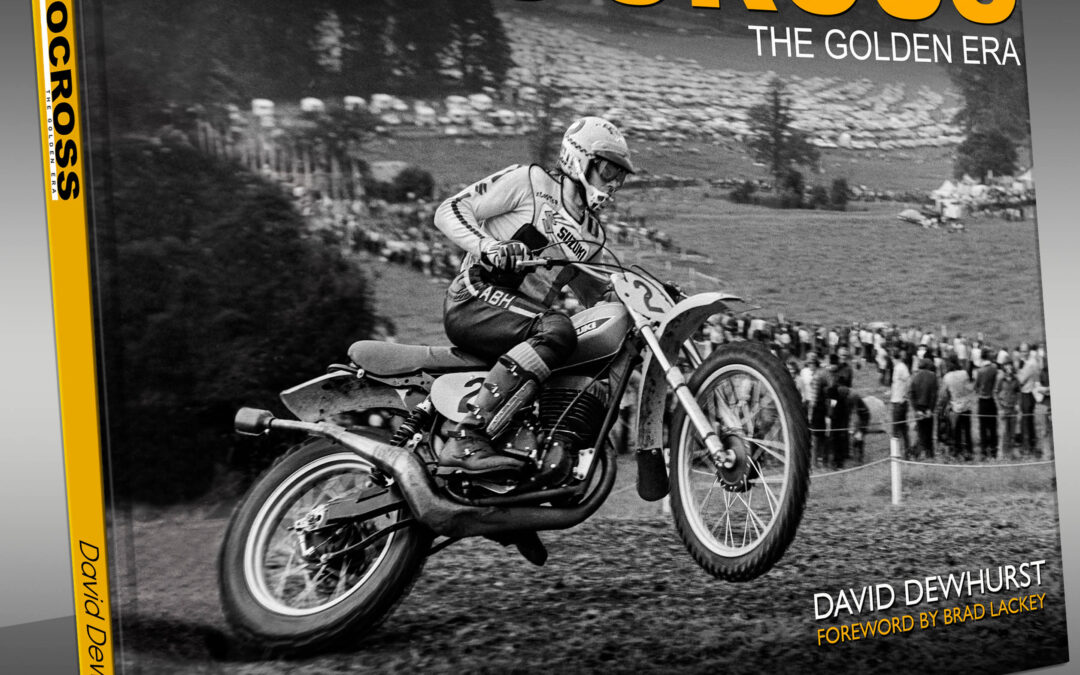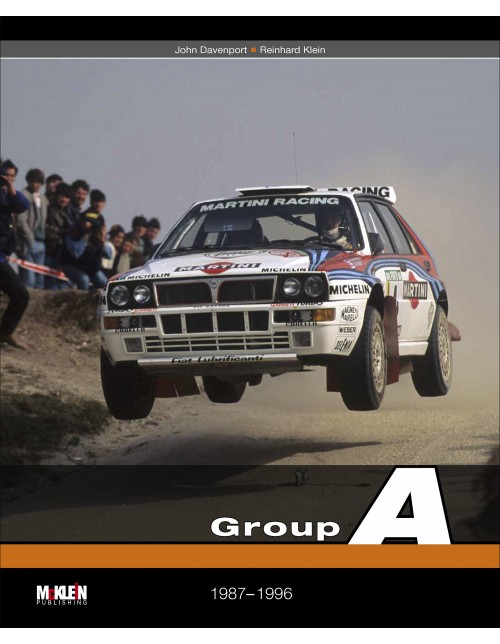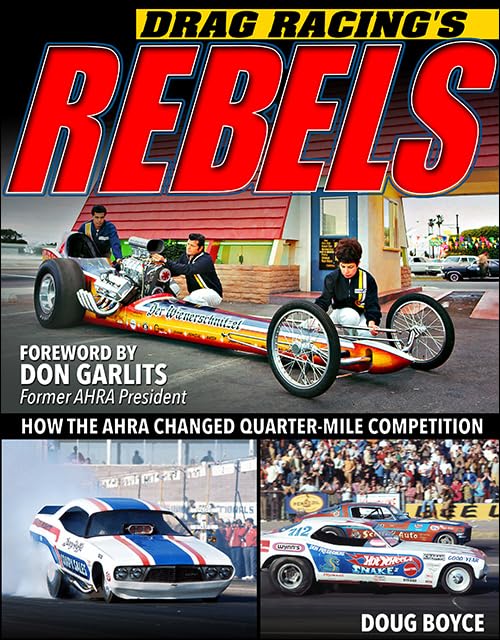
Learn the entire fascinating story of the American Hot Rod Association (AHRA) in this wonderfully illustrated color history.
When the National Hot Rod Association (NHRA) was formed in 1951 by Wally Parks, the reasoning for the formation was to “create order from chaos” by instituting safety rules and performance standards that helped legitimize the sport of drag racing. Some organization was certainly necessary. A postwar boom in automotive enthusiasm was reaching new heights, and Hot Rod magazine and the NHRA were right in the thick of it.
The NHRA hosted its first drag racing event in 1953, and in 1955, the organization staged its first national event, which was simply called “The Nationals.” The AHRA formed in 1956 as an alternative to the NHRA, where the drivers voted on the rules (rather than sanctioning bodies and tracks), and their influence on the sport was felt almost immediately.
When the NHRA denied the use of nitromethane in 1957, the AHRA approved it. When the NHRA banned aircraft-powered dragsters in 1961, the AHRA welcomed them. When the NHRA said no to the emerging Funny Car in 1965, the AHRA said yes. When fans and racers screamed for a heads-up Super Stock category in 1968, the AHRA delivered. The AHRA was called a rebel association. Some say that it was more of an association that got things done–to the delight of fans and racers. The AHRA was on equal ground with the NHRA by the 1970s, drawing enormous crowds and racer entries.
In this fascinating history, veteran author Doug Boyce tells the story of the AHRA: the rise, the competition, the events, and the eventual downfall of the organization. After AHRA President Jim Tice passed away in 1982, internal fighting for control of the association resulted in its doom. Get the whole story here, and add this wonderful volume to your drag racing library.

1994 was a watershed year for F1 in so many ways, the fatal accidents of Roland Ratzenberger and Ayrton Senna shook the sport to its core. What followed was mayhem. For the first time all the arguments are painstakingly examined in one book. Fresh insights, exclusive interviews, and a plethora of evidence is brought together in a story that is guaranteed to amaze and shock.
This book is a thorough examination of a turbulent season, including…
′ Rushed car changes
′ Teams unhappy with how the crisis was managed
′ A power struggle for control of the sport
′ Vague rules being exploited
′ Accusations of politically motivated penalties
′ An alleged cover-up after a horrific pit-lane fire
′ A controversial conclusion
It also saw Michael Schumacher and Benetton first emerge as championship contenders, upsetting the establishment. Many believed their sudden rise was down to cheating, whilst others felt they were scapegoated because of politics. For the first time all the arguments are painstakingly examined in one book. Fresh insights, exclusive interviews, and a plethora of evidence is brought together to give the clearest analysis yet into the above events. The book contains over 250 photos which help bring this story to life, many of which are rare and from those involved.
There are exclusive contributions from former F1 driver Mark Blundell, Benetton insiders: Willem Toet, Frank Dernie, Simon Morley (the “junior employee” blamed for the Hockenheim fire). Williams’ insiders Paul West and Richard Wise. You will be astonished at what is unearthed. 1994 was tragic, chaotic, political, technical and involved some very colorful characters at the heart of the action. It’s a story that will amaze.
′ Did Senna hear illegal traction control on Schumacher’s Benetton at Aida?
′ Concealed launch control was later found on Schumacher’s Benetton. Why?
′ Was the Hockenheim fire caused by Benetton removing their fuel filter?
′ Despite pleading guilty, why did Benetton receive no serious punishments after the fire?
′ Schumacher was banned / disqualified from a quarter of 1994 races due to various infringements. Politics or cheating?
′ Did a return to simpler cars contribute to the accidents?
The book seeks to answer these and many more questions.
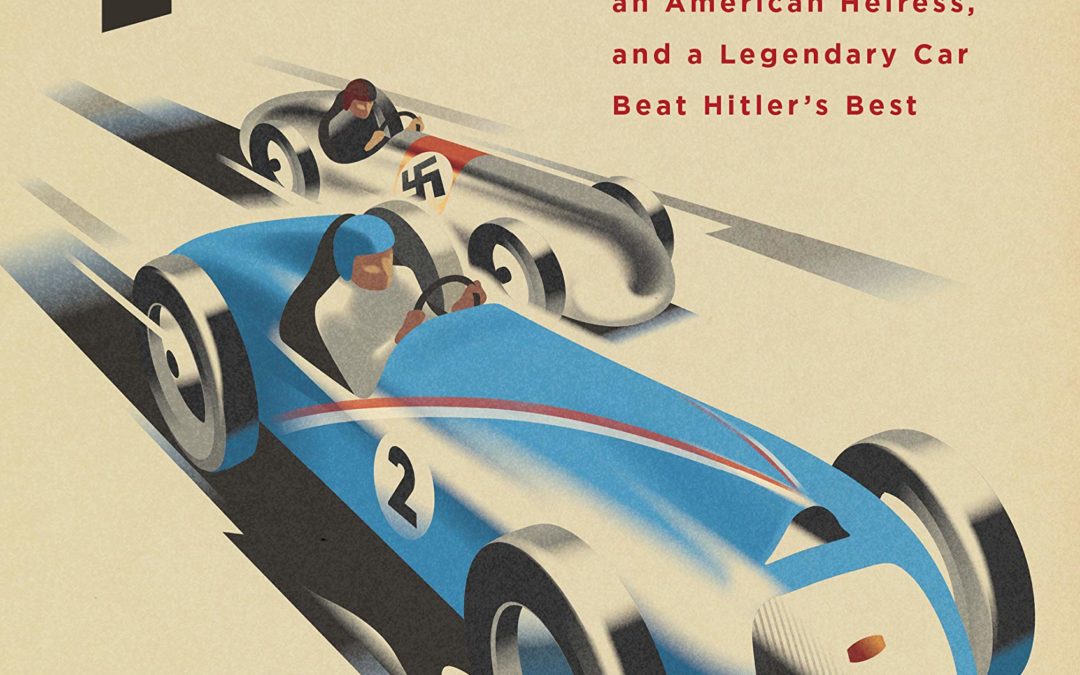
SIGNED
A pulse-pounding tale of triumph by an improbable team of upstarts over Hitler’s fearsome Silver Arrows during the golden age of auto racing.
They were the unlikeliest of heroes. Rene Dreyfus, a former top driver on the international race car circuit, had been banned from the best European teams—and fastest cars—by the mid-1930s because of his Jewish heritage. Charles Weiffenbach, head of the down-on-its-luck automaker Delahaye, was desperately trying to save his company as the world teetered toward the brink. And Lucy Schell, the adventurous daughter of an American multi-millionaire, yearned to reclaim the glory of her rally-driving days.
As Nazi Germany launched its campaign of racial terror and pushed the world toward war, these three misfits banded together to challenge Hitler’s dominance at the apex of motorsport: the Grand Prix. Their quest for redemption culminated in a remarkable race that is still talked about in racing circles to this day—but which, soon after it ended, Hitler attempted to completely erase from history.
Bringing to life this glamorous era and the sport that defined it, Faster chronicles one of the most inspiring, death-defying upsets of all time: a symbolic blow against the Nazis during history’s darkest hour.
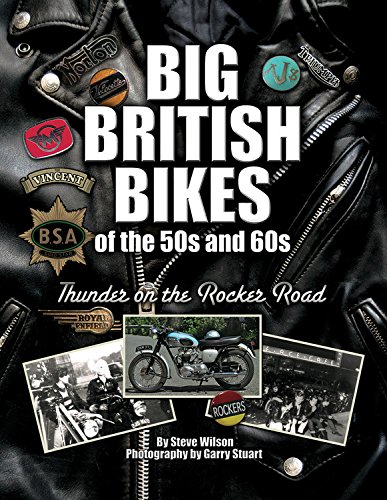
In the 1950s and ’60s the British motorcycle industry was at its postwar peak, with its large-capacity high-performance bikes in strong demand all over the world. AJS/Matchless, BSA, Norton, Royal Enfield and Triumph were all making 100mph-plus big twins, with the king of them all, at least into the 1950s, being the mighty1000cc Vincents, while among the ton-up singles were the BSA Gold Star and the Velocette Venom and Thruxton. In this book veteran motorcycle writer Steve Wilson reviews the top-of-the-line bikes of all these manufacturers, first giving an introduction to the motorcycling scene in the period, with a particular look at the emergence of the Rockers, the black-leather too-fast-to-live-too-young-to-die bikers who developed a culture all their own, inspired indirectly by Marlon Brando behaving badly on his Triumph Thunderbird in the banned-in-Britain 1953 movie The Wild One. Then the motorcycle makers are dealt with alphabetically, with their big bikes described in detail and their performance, handling, strengths and weaknesses discussed. In addition to a wide selection of archive photographs, specially commissioned colour photography features examples of the outstanding bikes of the period: AMC/Matchless CSR 650 twins and their Norton Atlas-engined ‘Hybrid’ siblings, BSA A7SS 500, Gold Star singles, AIO Super Rocket and Rocket Gold Star 650 twins, Norton SS 500/600/650 twins, Velocette Venom and Thruxton 500, Royal Enfield Constellation 700 twin, Triumph pre-unit 500 and 650 twins and unit Bonneville 650, and finally the Vincent 1000 vee-twin.
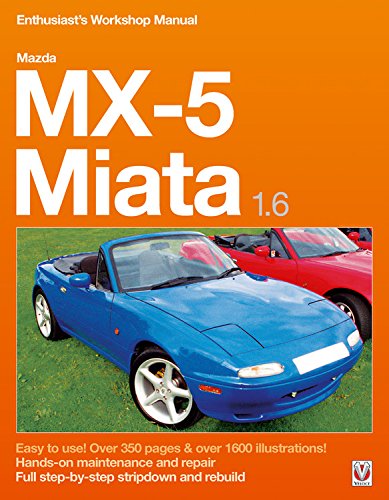
With open-topped styling and performance evocative of the classic sportscars of the 1960s, the Mazda MX-5/Eunos had to be a huge international success – and that’s exactly what it’s become. Now a familiar sight on the streets and boulevards of the world, the MX-5 is owned by real enthusiasts, the kind of people who will want to have hands-on involvement with the maintenance and repair of their prized possession. For those enthusiasts, here is what we believe to be the best, easiest to use workshop manual in the world.
Author Rod Grainger set out to create a new kind of owner’s workshop manual – friendly, easy to understand, easy to use, and yet more detailed than any other manual currently available: two years later, the Mazda MX-5 Miata 1.6 Enthusiast’s Workshop Manual was the result. Rod, and fellow enthusiasts Pete and Judith, stripped down an MX-5 in an ordinary domestic garage using ordinary tools and, in the process, took over 1,500 step-by-step photographs. The result of all this work is a superbly detailed text which passes on to the reader every detail of important jobs, including how problems can be overcome without resorting to special tools. This manual even tells the reader the size of nuts and bolts so they can start work with the right tools and all clearances and torque values are given in the text as the reader needs them. At paragraph level, a unique symbol system provides cross-references or tells the reader that there are helpful associated photos, drawings and tables. The dreaded words “reassembly is a reversal of the dismantling procedure” are banned, and every task, from changing a bulb to rebuilding the gearbox, is described in full. Besides detailed coverage of maintenance and repairs, this manual includes advice on rustproofing, cosmetic tuning and mechanical tuning. Rod’s manual was prepared with the assistance of Mazda, and it applies to all 1.6 litre models built between 1989 and 1995. Most of the manual is relevant to later 1.6 litre models, too.
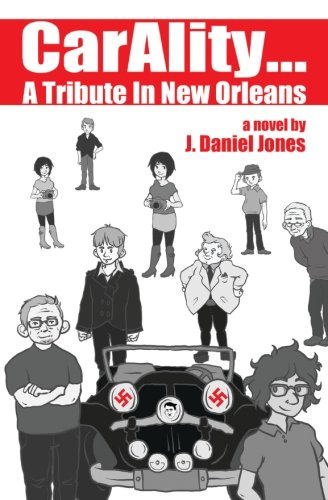
Antoine “Andy” Guidry is a down on his luck cable TV producer living well beyond his means in San Diego, CA.
He had risen through the ranks of camera op, field producer, and senior producer until he finally jumped ship and developed his own show… burning more than a few bridges on the journey. When his show was abruptly cancelled, it left him with little more than maxed out credit cards, severely overdue bills, and an increasingly virulent cannabis vaping habit.
Unsuccessful at trying to drum up work from former “once bitten-twice shy” associates, he is forced to sell his most treasured possession, a 1968 Porsche 911T Targa. Needing the money as soon as possible, he selects the next classic car auction he can find, A-Bears Classic Car Auction in New Orleans, LA. Being a Louisiana native, it feels like he’s returning home and starting all over again. At his age, that’s not a good thing.
Through an unforeseen twist of fate, he finds he is now the only TV producer on the planet with access to the coup of the auto auction universe. A previously undiscovered Mercedes-Benz 770K Grosser Tourenwagen, purportedly used by Adolf Hitler, is also being sold in the same auction as Andy’s cherished 911, and with about as much advance publicity.
Unfortunately, the consigner not only has no interest in television coverage, he’s actually banned it. He claims it’s due to the nature of the provenance, which may be as, or even more valuable than the car itself.
If he can find a loophole that will let him actually cover the auction, this could put him back in the game. He just needs to develop a concept, pitch it, get some front money, field a crew, sneak ’em in, and cover the classic car auction event of the century. Sure, it sounds a bit daunting. But he does, after all, have three whole days to pull it off.
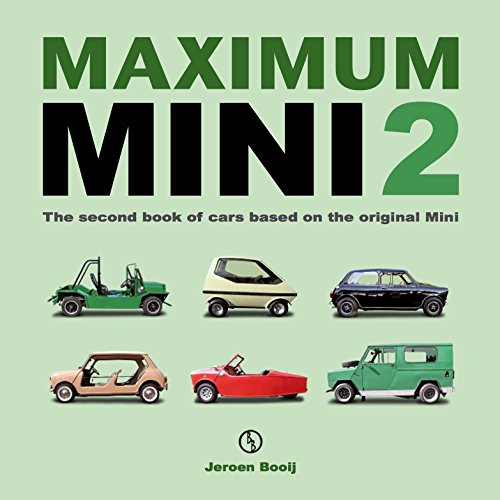
The long awaited sequel to Maximum Mini. Maximum Mini 2 describes another 60 cars based on the original Mini – none of which have been covered in the first book. It is illustrated with over 500 pictures that have not been seen in print before and describes the often remarkable ideas of budding motor manufacturers, much of it obtained by interviewing the designers themselves. In his researches Booij once more found some cars that were thought lost for decades. Highlights include the Mini Beach Car that was used by the British Royals; Owen Greenwood’s ‘four-wheeled motorbike’, which got banned from racing in the 1960s and the rare Quasar-Unipower City car: world’s first cube car that was wider and taller than it was long. Booij also found the Aurora GT, built for Lotus-driver Trevor Taylor and his sister Anita in 1965, which disappeared some years later. Some of the cars described are ingenious and beautifully designed; others excel due to the lack of styling, but fine or foolish – this book tells the tales about how they came to be, all of which are fascinating.
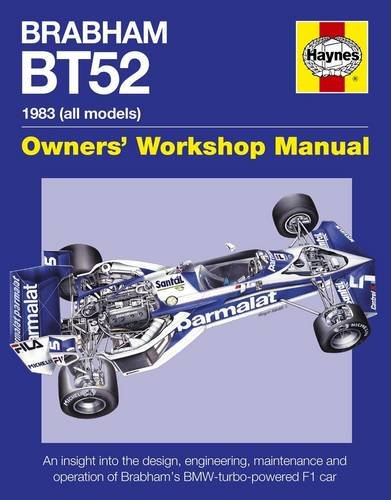
An insight into the design, engineering, maintenance and operation of Babham’s BMW-turbo-powered F1 car
Designed to suit new regulations, after ground-effect cars were banned at the end of 1982, the BT52 was very distinctive, with short, angular sidepods and a dart-shaped profile. During the 1983 season, the innovative Brabham team, with now F1 supremo Bernie Ecclestone at the helm, introduced the first high-pressure fuel rig seen in F1, to speed up refuelling stops, and used ‘ovens’ to pre-heat tyres prior to pitstops. This manual provides a fascinating insight into the design, evolution, operation and maintenance of the Brabham BT52.
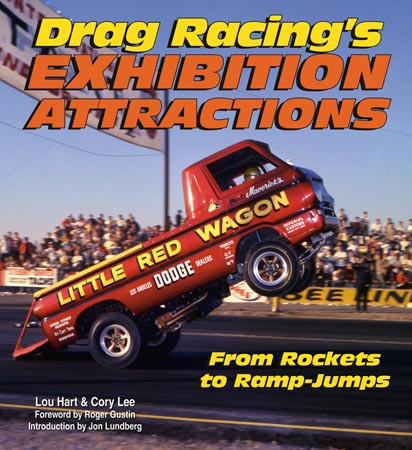
This book showcases photographically the wide variety of cars and drivers that fit into the exhibition theme: the jets, wheelstanders, rockets and other exhibition vehicles whicimageh have thrilled millions of spectators. Their entire basis was who had the fastest vehicle. But in 1959 complaints from other competitors and Detroit automakers got all aircraft-powered dragsters banned, so they became the sideshow attached to the legitimate circus that is drag racing. The Green Monster became the first exhibition car exceeding 200 mph everywhere it ran. Wanting even more, Walt Arfons debuted the first jet-powered dragster which became the desire of every fan and promoter throughout the country. At virtually the same instant, Tom Ivo had Kent Fuller build a four-engine dragster and although it was too heavy to be competitive, the tire-smoke show became arguably the most famous exhibition car in history. See Bill “Maverick” Golden and the Little Red Wagon, “Wild Bill” Shrewsberrys and the Hurst Hemi Under Glass, LA Dart and Knotts Berry Wagon, Chuck Poole and his Chuckwagon, Doug Rose and The Green Mamba, plus many more.
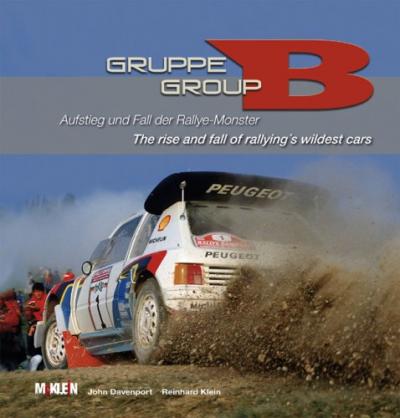
They were the most exciting cars ever to have graced the international rally scene. To this day, many fans still consider Group B to be the epitome of madness on wheels. Never since have engineers had such a big freedom of choice to create extreme rally cars as they did during that fantastic era of the early 1980s. This book tells the story of all the cars developed within Group B, from the Quattros to the outstanding Lancias and Peugeots and to the exotic sports cars from Porsche and Mazda. But all the technical development came to a head in the year 1986, when the euphoria somehow turned into an ungovernable risk. The mischief of engineers, politicians and fans led to tragic accidents, which finally resulted in Group B cars being banned from international rallies. John Davenport, rally-journalist and author of several books on rallying, experienced this era first-hand, as he was Motorsport Director of Austin Rover at the time. His comprehensive knowledge takes the reader on a journey into the fascinating world of these hi-tech rally cars and offers a authoritative insight into the power struggles going on behind the scenes. The book is filled with photographs from the archive of well known rally-photographer Reinhard Klein and they include many previously unseen pictures. By the use of large prints, they show to best effect the technical details of the cars, the slightly crazy ambiance of the time as well as plenty of action from the special stages.
Large Format: 30 x 32 cm
nearly 450 colour images

From Prep to Final Coat is a book that covers all the bases when it comes to restoring or painting a car or motorcycle. It is a complete guide for anyone who is thinking about or restores and or paints cars, trucks, hot rods or motorcycles. It’s designed for the beginner as well as as the more experienced painter or restorer. Its is without a doubt the most comprehensive book ever written on paint and bodywork.
Paint, bodywork, and restoration technology has changed quite a bit in the last 20 and even 10 years and this book is the most comprehensive guide to understanding and using that new technology such as waterborne paints, with easy to understand guides to getting the most out of the products being used.
The book is split into two parts. Part 1 covers everything: explaining solvent and waterborne paint and most materials used in the restoration and painting process, as well as the tools used for these tasks: understanding paint spray guns, welders, plasma cutters, air tools and hand tools. There are 12 step by step instruction chapters that show the processes of restoring and painting a classic musclecar, bodywork, panel bonding seam sealing, repairing and painting plastic and fiberglass parts, designing and mixing custom colors.
Part 1 also contains a very comprehensive and easy to understand guide to painting with waterborne paint. Recent EPA regulations have restricted solvent-based paints for use only in approved professional paint booths, meaning that do-it-yourselfers can no longer use them–and it won’t be long before their use is banned entirely.
Part 1 also features a chapter on Troubleshooting Paint Issues, and how to avoid them.
Part 2 contains 12 chapters that cover painting most kinds of custom artwork on hot rods and motorcycles. There are whole chapters devoted to painting ghost flames, real fire flames, flag graphics, cutting edge and retro flake graphics, wood grain and stone effect basecoats and even a chapter devoted to using waterborne paint to create classic traditional hot rod flames. And Chapter 26 shows how to apply a cleacoarcoat finish over all your hard work, then buff it to a glassy show car result.
JoAnn Bortles has put all her 34 years of restoration, bodywork, painting and custom artwork experience into one easy to follow step by step guide that packs an incredible amount of information into one book.
Automotive Paint from Prep to Final Coat is the first book to provide instruction and hows to for waterborne paints. In addition to this critical information, author and top professional painter JoAnn Bortles covers all the techniques necessary to get the great results your car deserves. From initial body-panel preparation, to troubleshooting common problems, to application of the final coat, and all steps in between, this book is the only reference you will need to ensure your DIY automotive paint job is done right the first time.


